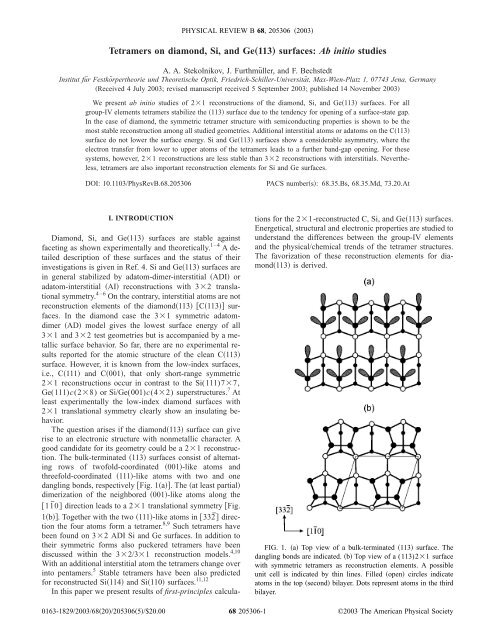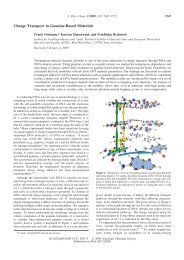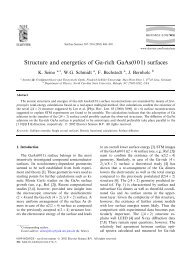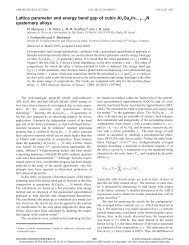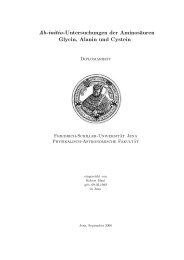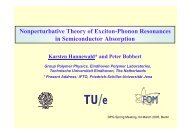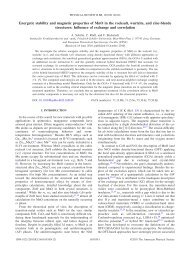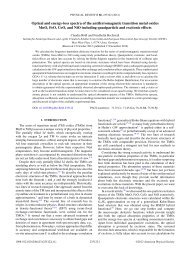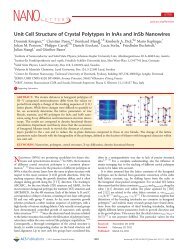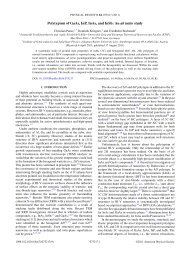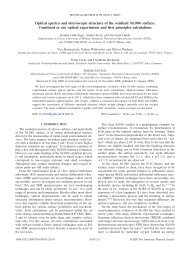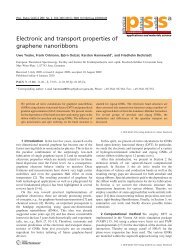Tetramers on diamond, Si, and Geâ113⦠surfaces: Ab initio studies
Tetramers on diamond, Si, and Geâ113⦠surfaces: Ab initio studies
Tetramers on diamond, Si, and Geâ113⦠surfaces: Ab initio studies
- No tags were found...
Create successful ePaper yourself
Turn your PDF publications into a flip-book with our unique Google optimized e-Paper software.
PHYSICAL REVIEW B 68, 205306 2003<br />
<str<strong>on</strong>g>Tetramers</str<strong>on</strong>g> <strong>on</strong> diam<strong>on</strong>d, <strong>Si</strong>, <strong>and</strong> Ge„113… <strong>surfaces</strong>: <strong>Ab</strong> <strong>initio</strong> <strong>studies</strong><br />
A. A. Stekolnikov, J. Furthmüller, <strong>and</strong> F. Bechstedt<br />
Institut für Festkörpertheorie und Theoretische Optik, Friedrich-Schiller-Universität, Max-Wien-Platz 1, 07743 Jena, Germany<br />
Received 4 July 2003; revised manuscript received 5 September 2003; published 14 November 2003<br />
We present ab <strong>initio</strong> <strong>studies</strong> of 21 rec<strong>on</strong>structi<strong>on</strong>s of the diam<strong>on</strong>d, <strong>Si</strong>, <strong>and</strong> Ge113 <strong>surfaces</strong>. For all<br />
group-IV elements tetramers stabilize the 113 surface due to the tendency for opening of a surface-state gap.<br />
In the case of diam<strong>on</strong>d, the symmetric tetramer structure with semic<strong>on</strong>ducting properties is shown to be the<br />
most stable rec<strong>on</strong>structi<strong>on</strong> am<strong>on</strong>g all studied geometries. Additi<strong>on</strong>al interstitial atoms or adatoms <strong>on</strong> the C113<br />
surface do not lower the surface energy. <strong>Si</strong> <strong>and</strong> Ge113 <strong>surfaces</strong> show a c<strong>on</strong>siderable asymmetry, where the<br />
electr<strong>on</strong> transfer from lower to upper atoms of the tetramers leads to a further b<strong>and</strong>-gap opening. For these<br />
systems, however, 21 rec<strong>on</strong>structi<strong>on</strong>s are less stable than 32 rec<strong>on</strong>structi<strong>on</strong>s with interstitials. Nevertheless,<br />
tetramers are also important rec<strong>on</strong>structi<strong>on</strong> elements for <strong>Si</strong> <strong>and</strong> Ge <strong>surfaces</strong>.<br />
DOI: 10.1103/PhysRevB.68.205306<br />
PACS numbers: 68.35.Bs, 68.35.Md, 73.20.At<br />
I. INTRODUCTION<br />
Diam<strong>on</strong>d, <strong>Si</strong>, <strong>and</strong> Ge113 <strong>surfaces</strong> are stable against<br />
faceting as shown experimentally <strong>and</strong> theoretically. 1–4 A detailed<br />
descripti<strong>on</strong> of these <strong>surfaces</strong> <strong>and</strong> the status of their<br />
investigati<strong>on</strong>s is given in Ref. 4. <strong>Si</strong> <strong>and</strong> Ge113 <strong>surfaces</strong> are<br />
in general stabilized by adatom-dimer-interstitial ADI or<br />
adatom-interstitial AI rec<strong>on</strong>structi<strong>on</strong>s with 32 translati<strong>on</strong>al<br />
symmetry. 4–6 On the c<strong>on</strong>trary, interstitial atoms are not<br />
rec<strong>on</strong>structi<strong>on</strong> elements of the diam<strong>on</strong>d113 C113 <strong>surfaces</strong>.<br />
In the diam<strong>on</strong>d case the 31 symmetric adatomdimer<br />
AD model gives the lowest surface energy of all<br />
31 <strong>and</strong> 32 test geometries but is accompanied by a metallic<br />
surface behavior. So far, there are no experimental results<br />
reported for the atomic structure of the clean C113<br />
surface. However, it is known from the low-index <strong>surfaces</strong>,<br />
i.e., C111 <strong>and</strong> C001, that <strong>on</strong>ly short-range symmetric<br />
21 rec<strong>on</strong>structi<strong>on</strong>s occur in c<strong>on</strong>trast to the <strong>Si</strong>(111)77,<br />
Ge(111)c(28) or <strong>Si</strong>/Ge(001)c(42) superstructures. 7 At<br />
least experimentally the low-index diam<strong>on</strong>d <strong>surfaces</strong> with<br />
21 translati<strong>on</strong>al symmetry clearly show an insulating behavior.<br />
The questi<strong>on</strong> arises if the diam<strong>on</strong>d113 surface can give<br />
rise to an electr<strong>on</strong>ic structure with n<strong>on</strong>metallic character. A<br />
good c<strong>and</strong>idate for its geometry could be a 21 rec<strong>on</strong>structi<strong>on</strong>.<br />
The bulk-terminated 113 <strong>surfaces</strong> c<strong>on</strong>sist of alternating<br />
rows of twofold-coordinated 001-like atoms <strong>and</strong><br />
threefold-coordinated 111-like atoms with two <strong>and</strong> <strong>on</strong>e<br />
dangling b<strong>on</strong>ds, respectively Fig. 1a. The at least partial<br />
dimerizati<strong>on</strong> of the neighbored 001-like atoms al<strong>on</strong>g the<br />
11¯0 directi<strong>on</strong> leads to a 21 translati<strong>on</strong>al symmetry Fig.<br />
1b. Together with the two 111-like atoms in 332¯ directi<strong>on</strong><br />
the four atoms form a tetramer. 8,9 Such tetramers have<br />
been found <strong>on</strong> 32 ADI <strong>Si</strong> <strong>and</strong> Ge <strong>surfaces</strong>. In additi<strong>on</strong> to<br />
their symmetric forms also puckered tetramers have been<br />
discussed within the 32/31 rec<strong>on</strong>structi<strong>on</strong> models. 4,10<br />
With an additi<strong>on</strong>al interstitial atom the tetramers change over<br />
into pentamers. 5 Stable tetramers have been also predicted<br />
for rec<strong>on</strong>structed <strong>Si</strong>114 <strong>and</strong> <strong>Si</strong>110 <strong>surfaces</strong>. 11,12<br />
In this paper we present results of first-principles calculati<strong>on</strong>s<br />
for the 21-rec<strong>on</strong>structed C, <strong>Si</strong>, <strong>and</strong> Ge113 <strong>surfaces</strong>.<br />
Energetical, structural <strong>and</strong> electr<strong>on</strong>ic properties are studied to<br />
underst<strong>and</strong> the differences between the group-IV elements<br />
<strong>and</strong> the physical/chemical trends of the tetramer structures.<br />
The favorizati<strong>on</strong> of these rec<strong>on</strong>structi<strong>on</strong> elements for diam<strong>on</strong>d113<br />
is derived.<br />
FIG. 1. a Top view of a bulk-terminated 113 surface. The<br />
dangling b<strong>on</strong>ds are indicated. b Top view of a (113)21 surface<br />
with symmetric tetramers as rec<strong>on</strong>structi<strong>on</strong> elements. A possible<br />
unit cell is indicated by thin lines. Filled open circles indicate<br />
atoms in the top sec<strong>on</strong>d bilayer. Dots represent atoms in the third<br />
bilayer.<br />
0163-1829/2003/6820/2053065/$20.00<br />
68 205306-1<br />
©2003 The American Physical Society
A. A. STEKOLNIKOV, J. FURTHMÜLLER, AND F. BECHSTEDT PHYSICAL REVIEW B 68, 205306 2003<br />
TABLE I. Surface energies of diam<strong>on</strong>d, <strong>Si</strong>, <strong>and</strong> Ge113 <strong>surfaces</strong><br />
per unit cell (E surf ) or per unit area (). Values for 31<br />
adatom-dimer AD, 32 AD oppositely puckered op, 32<br />
adatom-interstitial AI, <strong>and</strong> 32 adatom-dimer-interstitial ADI<br />
surface rec<strong>on</strong>structi<strong>on</strong>s are taken from Ref. 4.<br />
Rec<strong>on</strong>structi<strong>on</strong> E surf (eV/21 cell (J/m 2 )<br />
C <strong>Si</strong> Ge C <strong>Si</strong> Ge<br />
FIG. 2. Brillouin z<strong>on</strong>e of the 21-rec<strong>on</strong>structed 113 surface.<br />
II. COMPUTATIONAL METHOD<br />
Our calculati<strong>on</strong>s are performed within the density functi<strong>on</strong>al<br />
theory DFT in the local density approximati<strong>on</strong><br />
LDA. The interacti<strong>on</strong> of the electr<strong>on</strong>s with the atomic cores<br />
is treated by n<strong>on</strong>normc<strong>on</strong>serving ab <strong>initio</strong> ultrasoft<br />
pseudopotentials. 13 Explicitly we use the VASP code. 14 In the<br />
bulk case the DFT-LDA yields cubic lattice c<strong>on</strong>stants of a 0<br />
3.531, 5.398, <strong>and</strong> 5.627 Å <strong>and</strong> indirect fundamental energy<br />
gaps E g 4.15, 0.46, <strong>and</strong> 0.00 eV for diam<strong>on</strong>d, <strong>Si</strong>, <strong>and</strong><br />
Ge, respectively. As a c<strong>on</strong>sequence of the local density approximati<strong>on</strong><br />
for exchange <strong>and</strong> correlati<strong>on</strong> the lattice c<strong>on</strong>stants<br />
are slightly underestimated by about 1.0 C, 0.6 <strong>Si</strong>,<br />
or 0.6 Ge% with respect to the experimental values. In the<br />
ground-state calculati<strong>on</strong>s within DFT-LDA the excitati<strong>on</strong> aspect<br />
is not included <strong>and</strong>, hence, the gaps are also underestimated.<br />
Quasiparticle correcti<strong>on</strong>s of about 1.35 C, 0.66 <strong>Si</strong>,<br />
or 0.66 Ge eV have to be added to obtain the experimental<br />
gap values.<br />
The <strong>surfaces</strong> are modeled by repeated slabs. Each slab<br />
c<strong>on</strong>sists of 11 double layers <strong>and</strong> the same amount of vacuum<br />
layers. The bottom sides of the slabs are passivated by hydrogen<br />
atoms <strong>and</strong> kept frozen during the surface optimizati<strong>on</strong>.<br />
The topmost six double layers of the slab are allowed to<br />
relax. Eighteen k points are used in <strong>on</strong>e half of the Brillouin<br />
z<strong>on</strong>e BZ for <strong>surfaces</strong> with 21 translati<strong>on</strong>al symmetry. A<br />
symmetric slab is used to calculate the b<strong>and</strong> structure of the<br />
C(113)21 surface to avoid hydrogen-induced states within<br />
the fundamental gap. For the purpose of comparis<strong>on</strong> with<br />
results obtained for other rec<strong>on</strong>structi<strong>on</strong>s with varying numbers<br />
N of atoms in the slab, the surface energy E surf E tot<br />
N is studied instead of the total energy E tot of the slab. 7<br />
The chemical potentials of the atoms have been obtained<br />
from the total energies of the completely filled slabs. Divisi<strong>on</strong><br />
of E surf by the area of the studied surface results in ,<br />
the surface excess free energy per unit area at low temperature.<br />
Explicitly, we use the procedure described in Ref. 15.<br />
III. RESULTS AND DISCUSSION<br />
Bulk terminated 10.76 6.67 5.28 8.34 2.21 1.61<br />
21 symmetric 6.59 4.82 4.22 5.11 1.60 1.28<br />
21 asymmetric 4.41 3.37 1.46 1.03<br />
31 AD 7.10 4.50 3.53 5.50 1.49 1.08<br />
32 ADop 4.45 3.47 1.48 1.06<br />
32 AI 4.37 3.24 1.45 0.99<br />
32 ADI 4.23 3.26 1.40 0.99<br />
A top view <strong>on</strong> a group-IV(113)21 surface with symmetric<br />
tetramers as rec<strong>on</strong>structi<strong>on</strong> elements is presented in<br />
Fig. 1b. The two-dimensi<strong>on</strong>al lattice accompanying the<br />
21 rec<strong>on</strong>structi<strong>on</strong> is oblique. The corresp<strong>on</strong>ding BZ is<br />
shown in Fig. 2 together with the most important highsymmetry<br />
points. We studied a variety of symmetric <strong>and</strong><br />
asymmetric tetramers as starting c<strong>on</strong>figurati<strong>on</strong>s during the<br />
total-energy minimizati<strong>on</strong>. For diam<strong>on</strong>d(113)21 a symmetric<br />
tetramer is clearly identified as the most stable rec<strong>on</strong>structi<strong>on</strong><br />
element. Also the distances of the tetramer atoms<br />
with respect to the substrate remain almost unchanged. In the<br />
case of <strong>Si</strong> <strong>and</strong> Ge(113)21 the low-energy structures with<br />
21 translati<strong>on</strong>al symmetry are given by puckered tetramers.<br />
The tetramer atoms bel<strong>on</strong>ging to a diag<strong>on</strong>al pair go up or<br />
down with respect to the substrate in agreement with findings<br />
for puckered <strong>Si</strong> <strong>and</strong> Ge11331 <strong>and</strong> 32 models. 4,10 The<br />
occurrence of asymmetric rec<strong>on</strong>structi<strong>on</strong>s is similar to the<br />
observati<strong>on</strong>s for the dimer rec<strong>on</strong>structi<strong>on</strong> of the 001 <strong>surfaces</strong><br />
<strong>and</strong> the -b<strong>on</strong>ded chain rec<strong>on</strong>structi<strong>on</strong> in the case of<br />
the 111 <strong>surfaces</strong>. 7 Because of a str<strong>on</strong>ger b<strong>on</strong>ding strain in<br />
the subsurface layers asymmetric rec<strong>on</strong>structi<strong>on</strong>s are forbidden<br />
for diam<strong>on</strong>d <strong>surfaces</strong>.<br />
The resulting absolute surface energies <strong>and</strong> surface energies<br />
per unit area are summarized in Table I. They are compared<br />
with results obtained for 31 <strong>and</strong> 32 translati<strong>on</strong>al<br />
symmetries of AD, AI, or ADI models. 4 The 21 rec<strong>on</strong>structi<strong>on</strong><br />
gives rise to a substantial energy gain of 4.17 C,<br />
2.26 <strong>Si</strong>, <strong>and</strong> 1.91 (Ge) eV/21 cell with respect to bulk<br />
terminated <strong>surfaces</strong>. The comparis<strong>on</strong> of 21 results with the<br />
energies obtained for 31 <strong>and</strong> 32 rec<strong>on</strong>structi<strong>on</strong>s shows<br />
clearly that the 21 rec<strong>on</strong>structi<strong>on</strong> gives the most stable<br />
structure of the diam<strong>on</strong>d113 surface. With respect to the<br />
31 AD structure, there is an additi<strong>on</strong>al decrease of the<br />
surface energy by about 0.4 J/m 2 . The formati<strong>on</strong> of a symmetric<br />
tetramer per three 21 cells instead of two adatoms<br />
in the case of two 31 cells lowers the energy of the diam<strong>on</strong>d<br />
surface by 0.51 eV per 21 unit cell. This is expected<br />
for diam<strong>on</strong>d since adatoms also do not lead to a stable rec<strong>on</strong>structi<strong>on</strong><br />
of the C111 surface. 7<br />
The situati<strong>on</strong> is different for the <strong>Si</strong> <strong>and</strong> Ge113 <strong>surfaces</strong>.<br />
Interestingly see Table I the asymmetric tetramers also stabilize<br />
the <strong>Si</strong> <strong>and</strong> Ge113 <strong>surfaces</strong> more than the variety of<br />
originally suggested AD models with 31 or32 translati<strong>on</strong>al<br />
symmetries. 4 Only the coverage by additi<strong>on</strong>al interstitial<br />
atoms makes the AI 31/32 or ADI 32 rec<strong>on</strong>structi<strong>on</strong>s<br />
of <strong>Si</strong> <strong>and</strong> Ge113 <strong>surfaces</strong> energetically more favorable<br />
than the asymmetric-tetramer 21 rec<strong>on</strong>structi<strong>on</strong>. This<br />
205306-2
TETRAMERS ON DIAMOND, <strong>Si</strong>, AND Ge113 . . .<br />
PHYSICAL REVIEW B 68, 205306 2003<br />
FIG. 3. B<strong>and</strong> structures of C, <strong>Si</strong>, <strong>and</strong> Ge(113)21 <strong>surfaces</strong>.<br />
The b<strong>and</strong> structures in the upper panels are calculated for symmetric<br />
tetramers, while the lower <strong>on</strong>es represent asymmetric tetramers.<br />
FIG. 4. Wave-functi<strong>on</strong> squares of the lowest unoccupied c 2 a,<br />
c 1 b <strong>and</strong> highest occupied v 1 c, v 2 d surface b<strong>and</strong>s at P for the<br />
C(113)21 rec<strong>on</strong>structi<strong>on</strong>. In a <strong>and</strong> c cases side views are additi<strong>on</strong>ally<br />
plotted in the left panels in order to show the c<strong>on</strong>tributi<strong>on</strong>s<br />
below the tetramer plane.<br />
seems to be in complete agreement with the experimental<br />
findings. However, we menti<strong>on</strong> that for the layered system<br />
Ge/<strong>Si</strong>113 a22 rec<strong>on</strong>structi<strong>on</strong> has been observed. 16 Strain<br />
may be important for the stabilizati<strong>on</strong> of other rec<strong>on</strong>structi<strong>on</strong>s<br />
than 31 <strong>and</strong> 32 <strong>on</strong> <strong>Si</strong> <strong>and</strong> Ge113 <strong>surfaces</strong>.<br />
Another interesting aspect of the surface energies in Table<br />
I is obvious comparing with the corresp<strong>on</strong>ding values for<br />
other surface orientati<strong>on</strong>s <strong>and</strong> their lowest-energy rec<strong>on</strong>structi<strong>on</strong>s,<br />
111 4.06 (C-21), 1.36 (<strong>Si</strong>-77), <strong>and</strong> 1.01 J/m 2<br />
Ge-c(28) or 001 5.71 (C-21), 1.41 <strong>Si</strong>-c(42),<br />
<strong>and</strong> 1.00 Ge-c(42) J/m 2 . 15 The values for the 113 surface,<br />
even c<strong>on</strong>sidering <strong>on</strong>ly a 21 rec<strong>on</strong>structi<strong>on</strong>, are inbetween<br />
the values for the low-index <strong>surfaces</strong>. Not <strong>on</strong>ly for<br />
<strong>Si</strong> <strong>and</strong> Ge, rather also for diam<strong>on</strong>d the 113 surface should<br />
occur <strong>on</strong> the equilibrium crystal shape <strong>and</strong>, hence, represents<br />
a stable surface, although it is difficult to prepare experimentally.<br />
Due to the pr<strong>on</strong>ounced insulating character see below<br />
the C(113)21 surface is energetically more favorable than<br />
the clean C(001)21 surface which indeed has been<br />
prepared. 17<br />
In order to underst<strong>and</strong> the driving forces of the tetramer<br />
surface rec<strong>on</strong>structi<strong>on</strong>s of diam<strong>on</strong>d, <strong>Si</strong>, <strong>and</strong> Ge(113)21<br />
the corresp<strong>on</strong>ding resulting b<strong>and</strong> structures are plotted in<br />
Fig. 3 versus the variati<strong>on</strong> of the k points between highsymmetry<br />
points in the surface BZ Fig. 2. In c<strong>on</strong>trast to the<br />
C(113)31 surface with an AD rec<strong>on</strong>structi<strong>on</strong>, the<br />
diam<strong>on</strong>d(113)21 surface with tetramers shows a significant<br />
insulating behavior. Two neighbored empty surface<br />
b<strong>and</strong>s in the upper part of the projected fundamental gap are<br />
well separated from the two completely filled surface b<strong>and</strong>s<br />
somewhat below the valence-b<strong>and</strong> maximum VBM of the<br />
bulk b<strong>and</strong> structure. The indirect energy gap is related to a<br />
transiti<strong>on</strong> from the P line to the J point <strong>and</strong> amounts to 2.1<br />
eV within the DFT-LDA, i.e., half the value of the bulk gap.<br />
Surprisingly, already the symmetric tetramers give rise to the<br />
opening of a surface gap for <strong>Si</strong>(113)21, though the gap is<br />
small with 0.4 eV. This is not the case for the symmetricdimer<br />
rec<strong>on</strong>structi<strong>on</strong> of the <strong>Si</strong>(001)21 surface 15 for reas<strong>on</strong>s<br />
which will be seen discussing the nature of the electr<strong>on</strong>ic<br />
states below. A gap opening does not occur for<br />
symmetric tetramers <strong>on</strong> Ge(113)21. However, the predicti<strong>on</strong><br />
of the surface b<strong>and</strong> structure is difficult due to the remarkable<br />
b<strong>and</strong>-gap underestimate within the DFT-LDA already<br />
for bulk Ge. In any case, for <strong>Si</strong> <strong>and</strong> Ge there is a<br />
tendency to open the surface gap by puckering of the tetramers.<br />
The occupied b<strong>and</strong>s, in particular for Ge, are shifted into<br />
the projected valence b<strong>and</strong>s <strong>and</strong> <strong>on</strong>ly an empty surface state<br />
b<strong>and</strong> remains in the projected fundamental gap. However,<br />
due to its str<strong>on</strong>g dispersi<strong>on</strong> the Ge(113)21 surface with<br />
asymmetric tetramers remains metallic. The low positi<strong>on</strong> <strong>and</strong><br />
the str<strong>on</strong>g dispersi<strong>on</strong> of the lower surface b<strong>and</strong> for<br />
Ge(113)21 is a c<strong>on</strong>sequence of the bulk electr<strong>on</strong>ic structure.<br />
The bulk c<strong>on</strong>ducti<strong>on</strong>-b<strong>and</strong> states arising not far from the<br />
L point in the fcc BZ repel the surface b<strong>and</strong> at J which is in<br />
c<strong>on</strong>trast empty for C <strong>and</strong> <strong>Si</strong> towards lower energies even<br />
below the VBM. The general tendency of shifting the surface<br />
b<strong>and</strong>s <strong>and</strong> opening gaps between surface states with the<br />
asymmetry of the tetramers is in agreement with similar findings<br />
for the 111 <strong>and</strong> 001 low-index <strong>surfaces</strong> of <strong>Si</strong> <strong>and</strong><br />
Ge. 18,19<br />
The physical/chemical origin of the surface b<strong>and</strong>s is<br />
indicated in Figs. 4 <strong>and</strong> 5. The squares of the wave functi<strong>on</strong>s<br />
are plotted for the two lowest empty surface b<strong>and</strong>s <strong>and</strong><br />
the two highest occupied surface b<strong>and</strong>s for symmetric<br />
tetramers C(113)21, Fig. 4 <strong>and</strong> asymmetric tetramers<br />
<strong>Si</strong>(113)21, Fig. 5. The character of the four surface<br />
b<strong>and</strong>s within the fundamental gap is dominated by the six<br />
dangling-b<strong>on</strong>d orbitals situated at the four tetramer atoms<br />
<strong>on</strong>e <strong>on</strong> each 111-like atom or edge atom <strong>and</strong> two <strong>on</strong> each<br />
001-like atom or dimer atom of the tetramer as indicated<br />
in Fig. 1a for the surface atoms in bulk positi<strong>on</strong>s. Their<br />
linear combinati<strong>on</strong>s form the surface-state wave functi<strong>on</strong>s.<br />
Even for the symmetric case of diam<strong>on</strong>d, the two sp 3 orbitals<br />
of each 001-like atom cannot be dehybridized in such a<br />
way forming <strong>and</strong> orbitals with respect to the directi<strong>on</strong>s<br />
205306-3
A. A. STEKOLNIKOV, J. FURTHMÜLLER, AND F. BECHSTEDT PHYSICAL REVIEW B 68, 205306 2003<br />
FIG. 5. Wave-functi<strong>on</strong> squares of the lowest unoccupied c 2 a,<br />
c 1 c <strong>and</strong> highest occupied v 1 c, v 2 d surface b<strong>and</strong>s at P for the<br />
asymmetric tetramer rec<strong>on</strong>structi<strong>on</strong> of the <strong>Si</strong>113 surface. The<br />
b<strong>and</strong> v 2 d occurs in the projected b<strong>and</strong> structure of the valence<br />
b<strong>and</strong>s <strong>and</strong>, hence, is not indicated in Fig. 3. In a <strong>and</strong> c side views<br />
are also plotted in the left panels.<br />
113 <strong>and</strong> 11¯0 as in the classical dimer picture of 001<br />
<strong>surfaces</strong>. 18 In c<strong>on</strong>trast to 111 <strong>and</strong> 001 <strong>surfaces</strong> with exact<br />
<strong>and</strong> orbitals, six sp 3 -like dangling b<strong>on</strong>ds have to be<br />
discussed to explain the electr<strong>on</strong>ic structure of the tetramer.<br />
As a c<strong>on</strong>sequence, for diam<strong>on</strong>d <strong>on</strong>ly <strong>on</strong>e b<strong>on</strong>d al<strong>on</strong>g the<br />
11¯0 directi<strong>on</strong> is nearly formed by two sp 3 -like orbitals<br />
located at 001-like atoms. The remaining dangling b<strong>on</strong>ds<br />
str<strong>on</strong>gly interact with the dangling b<strong>on</strong>ds of the neighbored<br />
111-like edge atoms of the tetramer. In the case of<br />
diam<strong>on</strong>d(113)21 the distance of the two 001-like atoms<br />
in the tetramer amounts 99% of a bulk b<strong>on</strong>d length d bulk .<br />
This is in c<strong>on</strong>trast to a dimer b<strong>on</strong>d length 0.90 d bulk calculated<br />
for C(001)21. 15,18 Interestingly the two b<strong>on</strong>d lengths<br />
between edge <strong>and</strong> dimer atoms in the tetramer are reduced to<br />
0.89 d bulk . The reas<strong>on</strong> is a dimerlike behavior of two such<br />
atoms. Already in the bulk case a b<strong>on</strong>d exists. An additi<strong>on</strong>al<br />
b<strong>on</strong>d is formed by the two dangling hybrids of the<br />
edge <strong>and</strong> dimer atoms. No asymmetry occurs in the tetramer<br />
because of the str<strong>on</strong>g b<strong>on</strong>ding between the carb<strong>on</strong> atoms<br />
which takes place due to the lack of p <strong>and</strong> d electr<strong>on</strong>s in the<br />
atomic core. The tetramers nearly show a mirror symmetry<br />
al<strong>on</strong>g 332¯. They are almost planar. Only a small difference<br />
of 0.22 Å remains between dimer <strong>and</strong> edge atoms al<strong>on</strong>g the<br />
z directi<strong>on</strong> as an artifact of the atomic positi<strong>on</strong>s in the bulkterminated<br />
surface. As a c<strong>on</strong>sequence of the weak b<strong>on</strong>ding of<br />
the so-called dimer atoms, the occupied tetramer states in<br />
Fig. 4d are governed by antib<strong>on</strong>ding b<strong>on</strong>ding combinati<strong>on</strong>s<br />
of dangling orbitals at dimer atoms <strong>and</strong> b<strong>on</strong>ding antib<strong>on</strong>ding<br />
combinati<strong>on</strong>s of dangling orbitals located at edge<br />
<strong>and</strong> dimer atoms. However, there are also c<strong>on</strong>tributi<strong>on</strong>s from<br />
the orbitals around the central atom below the tetramer. The<br />
unoccupied states are dominated by antib<strong>on</strong>ding linear combinati<strong>on</strong>s<br />
of dangling b<strong>on</strong>ds located at the dimer <strong>and</strong> edge<br />
atoms.<br />
Because of the most favorable asymmetric puckered tetramer<br />
structures the surface states are completely changed<br />
for the <strong>Si</strong> <strong>and</strong> Ge(113)21 <strong>surfaces</strong> see Fig. 5. A tetramer<br />
does not anymore form a planar structure. Starting from the<br />
left edge atom, approaching the two so-called dimer atoms,<br />
<strong>and</strong> going around to the sec<strong>on</strong>d edge atom <strong>on</strong>e finds the<br />
following variati<strong>on</strong>s z in the vertical positi<strong>on</strong>s: 0, 0.91,<br />
0.29, <strong>and</strong> 0.77 Å 0, 0.98, 0.33, <strong>and</strong> 0.86 Å for <strong>Si</strong> Ge. The<br />
dimer b<strong>on</strong>d length between two 001-like atoms amounts to<br />
1.01 0.99 d bulk , whereas the lengths between 111 <strong>and</strong><br />
001 atoms are 0.97 0.95 d bulk for <strong>Si</strong>113 Ge113. For<br />
<strong>Si</strong>(113)21 the wave-functi<strong>on</strong> squares of the surface states<br />
are shown in Fig. 5. Because of their similarity those for Ge<br />
are not plotted. The c<strong>on</strong>sequence of the asymmetry of the<br />
tetramers is obvious. The different surface states at the P<br />
point in the BZ are mainly due to orbitals located at <strong>on</strong>e<br />
tetramer atom. The two lowest unoccupied states are localized<br />
at the two down atoms forming a diag<strong>on</strong>al of the tetramer.<br />
The two c<strong>on</strong>sidered occupied states are mainly localized<br />
at the two upper atoms. Energetically the lowest <strong>on</strong>e lies<br />
already in the projected bulk b<strong>and</strong> structure see Fig. 3. The<br />
situati<strong>on</strong> shows similarities to the asymmetric-dimer rec<strong>on</strong>structi<strong>on</strong><br />
of the <strong>Si</strong>(001)21 surface. The outgoing atoms<br />
become a more s-like dangling orbital, whereas the atoms<br />
displaced towards the substrate show a more p z -like character<br />
of the dangling orbital. Electr<strong>on</strong> transfer from the more<br />
p z -like orbitals into the more s-like orbitals is expected to<br />
lower the total energy of the system.<br />
The metastability of the symmetric tetramers, at least for<br />
<strong>Si</strong>(113)21, <strong>and</strong> the accompanying semic<strong>on</strong>ducting surface<br />
behavior gives additi<strong>on</strong>al insight in the occurrence of more<br />
or less symmetric tetramers in the case of the 32 ADI<br />
rec<strong>on</strong>structi<strong>on</strong> of both <strong>Si</strong> <strong>and</strong> Ge113 <strong>surfaces</strong>. The experimental<br />
<strong>and</strong> theoretical STM images of empty <strong>and</strong> occupied<br />
states of 32 structures show c<strong>on</strong>tributi<strong>on</strong>s from the tetramer<br />
atoms. 4–6 This means that electr<strong>on</strong>ic states should behave<br />
as is shown in Fig. 3 upper panel for the symmetric<br />
21 rec<strong>on</strong>structi<strong>on</strong>. Of course, in the case of 32 unit cells<br />
the <strong>surfaces</strong> are stabilized by the adsorpti<strong>on</strong> of interstitial<br />
atoms <strong>and</strong> by the presence of adatoms <strong>and</strong>, hence, is accompanied<br />
by a more complicated electr<strong>on</strong> distributi<strong>on</strong>. The tetramer<br />
states are pushed into the bulk projected b<strong>and</strong> structure,<br />
<strong>and</strong> c<strong>on</strong>sequently are seen in images with not too high<br />
bias voltages.<br />
One interesting point should be discussed here. While the<br />
metastable (111)21 <strong>surfaces</strong> represent low-temperature<br />
cleavage faces, the more complicated <strong>Si</strong>(111)77 or<br />
Ge(111)c(28) <strong>surfaces</strong> occur after annealing at elevated<br />
temperatures. 7 This may suggest to try to prepare the metastable<br />
<strong>Si</strong> <strong>and</strong> Ge(113)21 <strong>surfaces</strong> at lower temperatures<br />
not using the st<strong>and</strong>ard procedure 5 leading to a 32 rec<strong>on</strong>structi<strong>on</strong><br />
with interstitials. In the case of diam<strong>on</strong>d adatom<br />
<strong>and</strong> interstitial atoms are unfavorable. C<strong>on</strong>sequently, the surface<br />
structures with the lowest energies are C(111)21 <strong>and</strong><br />
C(113)21. Asymmetries are not allowed, neither in the<br />
-b<strong>on</strong>ded chains <strong>on</strong> 111 nor in the tetramers <strong>on</strong> 113.<br />
IV. SUMMARY<br />
In summary, using ab <strong>initio</strong> total energy <strong>and</strong> electr<strong>on</strong>icstructure<br />
calculati<strong>on</strong>s we have dem<strong>on</strong>strated that tetramers<br />
205306-4
TETRAMERS ON DIAMOND, <strong>Si</strong>, AND Ge113 . . .<br />
are important rec<strong>on</strong>structi<strong>on</strong> elements for diam<strong>on</strong>d, <strong>Si</strong>, <strong>and</strong><br />
Ge113 <strong>surfaces</strong>. The 21 translati<strong>on</strong>al symmetry with<br />
symmetric tetramers has been shown to represent the most<br />
stable diam<strong>on</strong>d113 surface. In c<strong>on</strong>trast to the C(113)31<br />
<strong>surfaces</strong> with adatoms <strong>and</strong> tetramers its b<strong>and</strong> structure exhibits<br />
a clear insulating character. The surface energy is even<br />
lower than that of the C(001)21 surface. Also, at least in<br />
the <strong>Si</strong>113 case, the formati<strong>on</strong> of tetramers tends to give rise<br />
to a semic<strong>on</strong>ducting surface. In particular, asymmetries due<br />
to the puckering of the tetramers support the opening of an<br />
energy gap between surface states. Because of the resulting<br />
low surface energy we suggest the observati<strong>on</strong> of tetramers<br />
<strong>on</strong> <strong>Si</strong> <strong>and</strong> Ge113 also with 21 translati<strong>on</strong>al symmetry.<br />
The appearance of rec<strong>on</strong>structi<strong>on</strong> elements, such as tetramers<br />
PHYSICAL REVIEW B 68, 205306 2003<br />
or interstitials, depends remarkably <strong>on</strong> the group-IV element<br />
C, <strong>Si</strong>, or Ge. We found that the general tendency for the<br />
occurrence of an asymmetry in the rec<strong>on</strong>structi<strong>on</strong> elements is<br />
widely independent of the surface orientati<strong>on</strong> 113, 111, or<br />
001 but is clearly related to the substrate, diam<strong>on</strong>d, or silic<strong>on</strong><br />
<strong>and</strong> germanium.<br />
ACKNOWLEDGMENTS<br />
We acknowledge financial support from the Deutsche Forschungsgemeinschaft<br />
Project No. Be1346/12-1 <strong>and</strong> the European<br />
Community in the framework of the Research <strong>and</strong><br />
Training Network NANOPHASE C<strong>on</strong>tract No. HPRN-CT-<br />
2000-00167.<br />
1 G. Medeiros-Ribeiro, A.M. Bratkovski, T.I. Kamins, D.A.A. Ohlberg,<br />
<strong>and</strong> R.S. Williams, Science 279, 353 1998.<br />
2 D.J. Eaglesham, A.E. White, L.C. Feldman, N. Moriya, <strong>and</strong> D.C.<br />
Jacobs<strong>on</strong>, Phys. Rev. Lett. 70, 1643 1993.<br />
3 G. Janssen, J.J. Schermer, W.J.P. van Enckevort, <strong>and</strong> L.J. Giling,<br />
J. Cryst. Growth 125, 421992.<br />
4 A.A. Stekolnikov, J. Furthmüller, <strong>and</strong> F. Bechstedt, Phys. Rev. B<br />
67, 195332 2003.<br />
5 J. Dabrowski, H.-J. Müssig, <strong>and</strong> G. Wolff, Phys. Rev. Lett. 73,<br />
1660 1994.<br />
6 A. Laracuente, S.C. Erwin, <strong>and</strong> L.J. Whitman, Phys. Rev. Lett.<br />
81, 5177 1998.<br />
7 F. Bechstedt, Principles of Surface Physics Springer, Berlin,<br />
2003.<br />
8 W. Ranke, Phys. Rev. B 41, 5243 1990.<br />
9 In the literature of the group-IV113 <strong>surfaces</strong> the element of the<br />
‘‘tetramer’’ structure built by two 001-like atoms is still called<br />
‘‘dimer’’ structure for historical reas<strong>on</strong>s.<br />
10 J. Wang, A.P. Horsfield, D.G. Pettifor, <strong>and</strong> M.C. Payne, Phys.<br />
Rev. B 54, 13744 1996.<br />
11 S.C. Erwin, A.A. Baski, <strong>and</strong> L.J. Whitman, Phys. Rev. Lett. 77,<br />
687 1996.<br />
12 T. An, M. Yoshimura, I. Ono, <strong>and</strong> K. Ueda, Phys. Rev. B 61, 3006<br />
2000.<br />
13 J. Furthmüller, P. Käckell, F. Bechstedt, <strong>and</strong> G. Kresse, Phys. Rev.<br />
B 61, 4576 2000.<br />
14 G. Kresse <strong>and</strong> J. Furthmüller, Comput. Mater. Sci. 6, 151996;<br />
Phys. Rev. B 54, 11169 1996.<br />
15 A.A. Stekolnikov, J. Furthmüller, <strong>and</strong> F. Bechstedt, Phys. Rev. B<br />
65, 115318 2002.<br />
16 Z. Zhang, K. Sumitomo, H. Omi, T. Ogino, J. Nakamura, <strong>and</strong> A.<br />
Natori, Phys. Rev. Lett. 88, 256101 2002.<br />
17 R. Graupner, M. Hollering, A. Ziegler, J. Ristein, L. Ley, <strong>and</strong> A.<br />
Stampfl, Phys. Rev. B 55, 10841 1997.<br />
18 P. Krüger <strong>and</strong> J. Pollmann, Phys. Rev. Lett. 74, 1155 1995.<br />
19 F. Bechstedt, A.A. Stekolnikov, J. Furthmüller, <strong>and</strong> P. Käckell,<br />
Phys. Rev. Lett. 87, 016103 2001.<br />
205306-5


